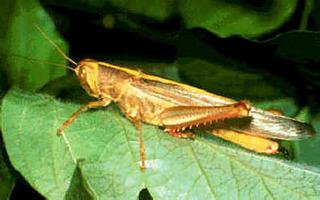


|
 |
Order -
ORTHOPTERA
(Greek, orthos =
straight; pteron = wing)
Common Names:
grasshoppers, locusts, crickets, katydids
Distribution:
Cosmopolitan
Description
Members of Orthoptera
have antennae which may be extremely long (extend beyond the insectís body
length) or relatively short (less than one third of the body length) but in all
cases the antennae are constructed of short, straight segments (filiform).
Prominent compound eyes are usually present and simple eyes (ocelli) may be
present. All species have well developed mandibles which in some cases may be so
large as to be capable of producing an unpleasant bite (e.g. the tree cricket,
Paragryllacris combusta). The rear pair of legs are almost always modified for
jumping and are frequently spiny. Numerous species use the leg spines and/or
specially modified sections of the wings to produce sounds that are used in
courtship; the "chirping" of crickets at dusk is commonly heard in
gardens. There are two pairs of wings but the forewings are usually modified so
that they become leathery wing protectors (tegmina).
Females are equipped with a tube at the end of the abdomen (ovipositor) which is
used to insert eggs into a suitable substrate. Many species of locust lay their
eggs directly into soil but other species glue their eggs onto leaves.
Nymph
There is no metamorphic cycle of egg, larva, pupa and adult. The young
emerge from the eggs as wingless miniatures of the adults (nymphs) and
mature through moults. In some cases it is difficult to distinguish
between the last few stages of winged insects and sexually mature adults.
Members
Grasshoppers, locusts, katydids, crickets.
Food
Most grasshopper and katydid species eat plants, either fresh or dry. Many
crickets actively hunt insects or similar prey.
Importance
Grasshoppers and katydids
are more of a nuisance than damaging pests in household gardens. However,
locusts have always been known as major pests to farmers. Enormous quantities of
eggs are laid by locust swarms and some estimates have been as much as one
billion eggs per hectare. Huge locust swarms can totally destroy cereal crops
and have contributed to famine in Africa and Asia. The insects are wasteful
feeders as they tend to attack stems and the whole plant is then destroyed.
|